Last Updated on January 6, 2024 by Greg Gillson
I’ve put this resource together for you to answer your question: What birds are in my backyard in Texas?
This article lists and discusses the identification of the most common birds in your backyard. The birds chosen in this article are compiled from actual data from the citizen science program eBird. Thus, it is more accurate than some other similar articles you may find on the web. I provide pictures of each bird species mentioned and I’ll tell how to attract them to your backyard.
These are the most common backyard birds in Texas:
- Northern Cardinal
- Northern Mockingbird
- Mourning Dove
- White-winged Dove
- House Sparrow
- Blue Jay
- Carolina Wren
- Carolina Chickadee
- European Starling
- Eastern Phoebe
- Yellow-rumped Warbler
- American Crow
- House Finch
- Red-bellied Woodpecker
- Barn Swallow
- Ruby-crowned Kinglet
- Black-crested Titmouse
- White-eyed Vireo
- Downy Woodpecker
- Orange-crowned Warbler
- American Goldfinch
- American Robin
- Western Kingbird
- Brown-headed Cowbird
- Savannah Sparrow
- Cedar Waxwing
- Golden-fronted Woodpecker
- Loggerhead Shrike
- Bewick’s Wren
- Eastern Bluebird
- Chipping Sparrow
- Scissor-tailed Flycatcher
- Painted Bunting
- Black-chinned Hummingbird
- Chimney Swift
- Red-winged Blackbird
Texas Birds and Birding in Texas State
eBird lists over 680 types of birds as occurring in the state of Texas.
The most common bird in Texas: the most frequently seen bird in the state is Northern Cardinal. It is reported on 48% of bird watching lists.
If you are serious about knowing the birds native to Texas, then check out eBird for Texas. It has recent sightings and photos, illustrated checklists with weekly abundance bar charts for state, counties, and individual hotspots of the best birding locations.
If you want to know about other people interested in birds in your area, join a local bird group. The American Birding Association maintains a list of bird watching clubs for each state.
Texas Bird Identification
This section is the species accounts. These are designed to help you to recognize birds you see in your backyard. I have used eBird to select the birds that are most common. “Common” means the birds seen most often throughout the year, not necessarily the most numerous.
Each species account starts with an image. In the identification section I am using size and shape and bill type before considering the color or patterns on the birds. I find these more reliable when trying to identify an unknown bird. Pay attention to body and tail shape and especially bill shape of birds you see, not just plumage color.
In the section on bird feeders and foods I tell how to attract each species. Not all types of backyard birds will come to feeders. But all backyard birds can be attracted with water. So don’t forget to add a birdbath to your bird feeding station.
Do you live in Northern Texas? Southern Texas? Central Texas? Southeastern Texas? Southwestern Texas? To appear in this article, most birds are widely distributed throughout the state and are often year-round residents. However, for those birds that are more localized in place or time, I list the general region and seasonality. Please see the section following these species accounts for the lists of common species by season.
Even if a species is found in a general area, they occur only in the habitat they prefer. So, the exact habitat of your neighborhood is important for the presence of absence of certain kinds of birds.
1. Northern Cardinal (Cardinalis cardinalis)
This is one of the most common and popular backyard birds in the eastern half of the United States.
 |
| Northern Cardinal. GeorgeB2 from Pixaby |
Range in Texas: Northern Cardinals are year-round residents throughout Texas.
Identification:
Size: Cardinals are a bit smaller than American Robins, about the same size as Red-winged Blackbirds.
Shape: Plump body with fairly long full tail. Wispy crest.
Bill: Short, heavy, conical, pink.
Color: That bright red color is matched by few other birds. Black face. The female is grayer, but with hints of red in wings and tail, and has a crest, too.
Habitat, range & behavior: Cardinals are year-round residents in shrubby woodland edges.
Found from the eastern United States to Texas and Arizona south into Mexico.
That large conical bill is made for chewing seeds. Watch them crack open sunflower seeds, spit out the hulls, and pluck the kernel with their tongues!
Food and feeder preference: Attract with black oil sunflower seeds. Many types of seeds, berries, nuts in larger hopper or tray feeders.
You may like my in-depth article on attracting Northern Cardinals.
2. Northern Mockingbird (Mimus polyglottos)
This bird sings from exposed perches most of the year and often through the night. They have an unending supply of their own unique short phrases that they repeat about 3 times each, but frequently intersperse songs of other birds.
 |
| Northern Mockingbird. Greg Gillson |
Range in Texas: Northern Mockingbirds are year-round residents throughout Texas.
Identification:
Size: The length of an American Robin.
Shape: Slender and long tailed. Long legs.
Bill: Medium length, slender, slightly curved.
Color: Gray, darker above, with white patches in wing and tail.
Habitat, range & behavior: They prefer edge habitat with scattered trees and bushes, parks and residential areas.
It is found in eastern and southern parts of the US, West Indies, and south into Mexico. In summer birds are found a bit farther north.
They boldly defend their nests from other birds, cats, and intruders.
Food and feeder preference: Eats insects, berries, and fruit. You may attract mockingbirds to your feeder with grapes, raisins, apple slices. They will come to a suet block. They readily use a bird bath.
3. Mourning Dove (Zenaida macroura)
Mourning Doves are the most widespread and most frequent backyard bird in the Lower 48 states of the United States.
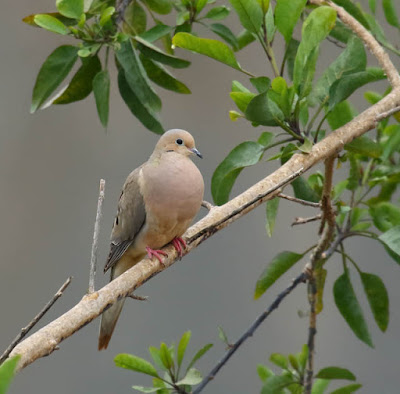 |
| Mourning Dove. Greg Gillson |
Range in Texas: Mourning Doves are year-round residents throughout Texas.
Identification: This is a key species for comparing with an unknown bird.
Size: About 12 inches long from bill tip to tail tip. About same size as Northern Flicker. Larger than American Robin. Slightly smaller than domestic city pigeon.
Shape: Very plump with a small round head. Tail is long and pointed. Legs are short.
Bill: Small and rather slender.
Color: Pale brown-pink body, darker wings and tail. White edges on side of tail.
Habitat, range & behavior: Semi-open areas such as urban areas, farmlands, woods. Often seen perched on wires, fences.
It is a resident across the lower-48 states and Mexico, with some movement out of northern areas in winter.
Their mournful cooing is a familiar spring birdsong.
Food and feeder preference: Mourning Doves eat seeds almost exclusively. Attract with black oil sunflower seeds on a large sturdy tray feeder or on the ground.
4. White-winged Dove (Zenaida asiatica)
This desert dove can be locally common in desert towns.
 |
| White-winged Dove. Greg Gillson |
Range in Texas: White-winged Doves are summer residents throughout most of Texas but absent as a breeder in the panhandle and southeast corner. White winged Doves are year-round residents in the south-central and southwestern part of Texas. White-winged Doves are winter visitors along the Gulf Coast in the southeast part of Texas.
Identification:
Size: A bit larger than a Mourning Dove.
Shape: A more muscular neck than Mourning Dove. A square tail.
Bill: Short and slender.
Color: Brown with black under tail base and broad white tip. White wing patches in flight, also visible when perched.
Habitat, range & behavior: Desert thickets, saguaro cacti and towns.
Found in the southwestern United States, Middle American, and West Indies.
They often seek water in the morning and afternoon.
Food and feeder preference: They eat seeds, grain, and fruit of the saguaro cactus. They are more likely to feed on a raised platform feeder than on the ground. They will eat black oil sunflower seeds and cracked corn.
5. House Sparrow (Passer domesticus)
Like the starling, this is another bird introduced from Europe in the 1800’s. This sparrow is commonly found in cities and farmlands. It is considered a pest in most areas where it has been introduced.
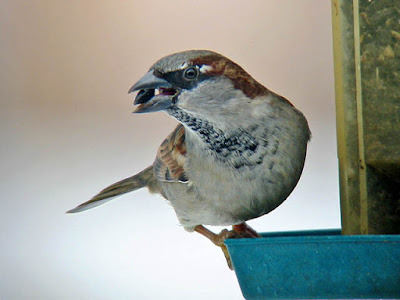 |
| House Sparrow. Greg Gillson |
Range in Texas: House Sparrows are year-round residents throughout Texas.
Identification:
Size: The size of a House Finch or Dark-eyed Junco.
Shape: Chunkier than native North American sparrows with large head, barrel chest, short neck, medium tail, short legs.
Bill: Short, conical.
Color: Males are brown and gray with a black mask. Females lack the black and are tan and brown with a pale line back from the eye.
Habitat, range & behavior: Cities and farms.
Range in North American from southern Canada through Central America. In summer northward through Canada to southern Alaska. Originated in Middle East and spread to most of Europe and Asia. Introduced in South America, Africa, Australia–nearly anywhere there are people and cities.
They tend to be messy… and have a good appetite and may occur in large noisy chirping flocks. They are aggressive toward other feeder birds.
Food and feeder preference: They eat grain, seed, and insects. To discourage them from your hopper and tray feeders do not feed birds human food scraps. They have a bit of difficulty eating from tube feeders.
6. Blue Jay (Cyanocitta cristata)
A common and well-known bird in the eastern half of the United States.
 |
| Blue Jay. skeeze from Pixabay |
Range in Texas: Blue Jays are year-round residents throughout most of Texas, except winter visitors only all along the Mexican border and southwestern Gulf Coast.
Identification:
Size: About that of American Robin.
Shape: Fluffy, large crested head, ample tail. Large strong legs.
Bill: Black, long and stout.
Color: Blue above, white below. Black neck strap. White patches in wing.
Habitat, range & behavior: Woodlands and towns.
Found in the eastern half of the United States. In summer into southern Canada.
Bold and brash. May bully smaller birds. Jays gulp lots of seeds or other food at once, storing it in their crop. Then they fly off and bury food items in a hidden cache.
Food and feeder preference: Omnivorous. They can quickly empty your feeder! Because they are also aggressive toward other feeder birds, some people put mesh cages around smaller bird feeders. Small birds can go through, squirrels and larger “pest” birds are prevented entry. Some people feed jays peanuts, perhaps away from the seed feeders.
7. Carolina Wren (Thryothorus ludovicianus)
This is a fairly common backyard bird in the much of the eastern United States.
 |
| Carolina Wren. theSOARnet from Pixabay |
Range in Texas: Carolina Wrens are year-round residents in the eastern half of Texas.
Identification:
Size: A smaller bird, between the size of American Goldfinch and House Finch.
Shape: Round body, short neck, flat head, long tail flipped about actively.
Bill: Fairly long, thin, pointed and slightly curved.
Color: Upper parts rusty brown with black bars on the wings and tail. A white eyebrow line and buff under parts.
Habitat, range & behavior: Shrubby thickets and brushy suburban yards.
It is found in the southeastern United States and Yucatan. Northern parts of range expand and contract depending upon harshness of winters.
Males sing throughout the year and are very loud for their size.
Food and feeder preference: Feed mostly on insects and spiders. They will feed on suet.
8. Carolina Chickadee (Poecile carolinensis)
Chickadees are common feeder birds throughout much of North America. This one is common in the southeastern United States.
 |
| Carolina Chickadee. GeorgeB2 from Pixabay |
Range in Texas: Carolina Chickadees are year-round residents in the eastern parts of Texas south to the Gulf Coast, except absent from the western panhandle southward, continuing its absence all along the Mexican border and adjacent Gulf Coast.
Identification:
Size: This small bid is the size of an American Goldfinch.
Shape: Round body, round head, longer tail.
Bill: Short, straight, stout.
Color: Gray above. Paler below. Black cap, white face, black bib.
Habitat, range & behavior: Lower elevation deciduous forests, wooded residential areas.
This chickadee is a resident in the southeastern US.
Chickadees cannot chew as sparrows do, so they take one large sunflower seed at a time from your feeder and fly off to a branch to pound it open with their stout bills.
Food and feeder preference: Most of their diet is insects, also seeds. Attract with black oil sunflower seeds from hopper feeders.
9. European Starling (Sturnus vulgaris)
Introduced to North America in the late 1800’s, they crossed the continent, often to the detriment of native cavity-nesting birds. The prime example of an invasive species.
 |
| European Starling. Greg Gillson |
Range in Texas: European Starlings are year-round residents throughout Texas.
Identification:
Size: About the size of a Red-winged Blackbird. Smaller than an American Robin. Larger than a White-crowned Sparrow or Spotted/Eastern towhee.
Shape: Stocky with large head, short square-ended tail. Longer legs.
Bill: As long as head. Sharp pointed. Yellow in spring, otherwise dark.
Color: They are grayish brown much of the year, with glossy iridescence and white spotting during the spring.
Habitat, range & behavior: Lowland birds that need trees large enough for nest cavities but plenty of open area for feeding. They are most abundant in urban and suburban areas where they find food and artificial nest cavities.
Resident from coast-to-coast from southern Canada to northern Mexico. In summer north across Canada and Alaska. Native range is Europe to Pakistan, north Africa.
Often viewed as a pest, starlings often bully other backyard birds, taking over bird feeders, and stealing nest cavities from smaller native birds. In winter they can form into flocks of tens of thousands.
Food and feeder preference: Their diet is primarily insects when available, often feeding on the ground. Discourage them from your backyard hopper and tray feeders by never feeding birds table scraps (including bread or meat). They have weak feet and do not perch well on tube feeders. A cage mesh around smaller hopper feeders may keep them out.
10. Eastern Phoebe (Sayornis phoebe)
This plain bird is common in backyards in the East.
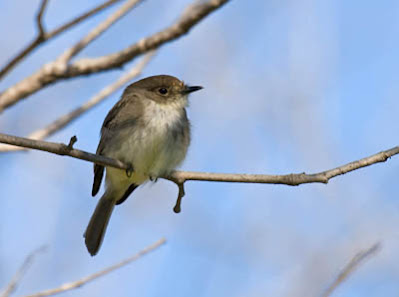 |
| Eastern Phoebe. Greg Gillson. |
Range in Texas: Eastern Phoebes are year-round residents in central and northeastern Texas, winter visitor only in the southern parts of Texas, and migrant only in the panhandle.
Identification:
Size: About the size of bluebirds. Larger than House Sparrows.
Shape: Rather stout, with long wings, medium-length tail. Pointed but flat bill. Upright posture.
Bill: Black, pointed, wide and flat.
Color: Brownish-gray above, slightly yellow-olive on sides. White under tail coverts. No eye ring or wing bars help distinguish them from some other flycatchers.
Habitat, range & behavior: Found in woodlands, suburbs, farms. Frequently nest in rafters, under eaves, porches.
They are summer residents east of the Rocky Mountains from Canada southward. Year-round residents through the interior of the Southeast, to Texas. Winter visitor to Gulf Coast and southern Atlantic.
Phoebes pump their tail down. They also frequently spread their tails.
Food and feeder preference: Diet is flying insects that they catch on the wing. Not a feeder visitor.
11. Yellow-rumped Warbler (Setophaga coronata)
An abundant winter visitor in California to treetops and weedy areas.
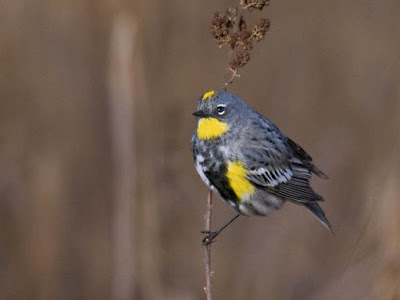 |
| Yellow-rumped Warbler. Greg Gillson. |
Range in Texas: Yellow-rumped Warblers are winter visitors throughout Texas. The eastern/northern form winters throughout. The western form winters in the western half of Texas and breeds in high mountains in far western Texas near the border with New Mexico.
Identification:
Size: Small, they are a bit larger than chickadees and goldfinches. They are smaller than House Finches and juncos.
Shape: Plump and neckless with a shorter tail.
Bill: Short, slender, straight, pointed.
Color: Breeding plumage in spring is blue-gray on the upper parts, black sides and chest, yellow rump, yellow on sides. Two forms: western form with yellow throat and large white wing patch; eastern and northern form with white throat and two white wing bars. In winter plumage both forms are gray brown above, pale cream below. Yellow rump and white tail corners in flight.
Habitat, range & behavior: In breeding season mostly in coniferous or mixed forests, in mountains in west. In winter open areas with fruiting shrubs and scattered trees.
Breed across Canada and Alaska and in conifer forests in the west. Winter along both coasts and the southern states through Middle America. There are also non-migratory forms in Mexico and Guatemala.
They tend to forage in outer branches about half way up the tree.
Food and feeder preference: Yellow-rumped Warblers eat mainly insects in the summer. They switch to waxy berries and fruit in winter. They are thus able to winter farther north than other warblers. They are attracted to suet feeders.
12. American Crow (Corvus brachyrhynchos)
This larger all-black bird is common in cities and country. Its cawing call is familiar to most people.
 |
| American Crow. Greg Gillson |
Range in Texas: American Crows are year-round residents in the northern and eastern half of Texas.
Identification: This is a key species for comparing with an unknown bird.
Size: About 17-1/2 inches long from bill tip to tail tip, though there is much size variation throughout its range. Larger than blackbirds and grackles. Smaller than ravens.
Shape: Thick neck, large head, rather short square-ended tail. Longer legs. In flight has rounded wing tips with each primary feather separated from others forming “fingers.”
Bill: As long as head, thick, black.
Color: Glossy black throughout.
Habitat, range & behavior: They prefer open areas with trees, fields, farms, cities.
They are common across most of the United States lower-48, except in the desert southwest. They move into southern Canada in summer.
They gather in evening communal roosts in large flocks that may number into the thousands and then move out at dawn into the surrounding area.
Food and feeder preference: Omnivorous, they feed on large insects, grain, small mammals, carrion. You probably don’t want these large entirely black birds in your backyard feeders. So don’t feed table scraps to birds.
13. House Finch (Haemorhous mexicanus)
These are one of the most common backyard birds in the United States. There are other red finches, but these are the ones most likely in residential areas.
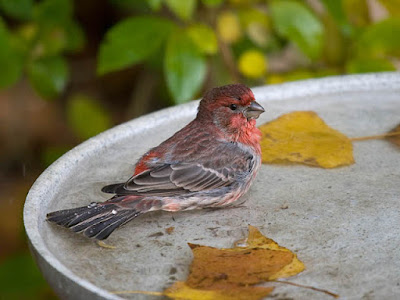 |
| House Finch. Greg Gillson. |
Range in Texas: House Finches are year-round residents in the western 2/3 of Texas.
Identification: This is a key species for comparing with an unknown bird.
Size: About 6 inches from bill tip to tail tip. Larger than goldfinches and chickadees. Smaller than a White-crowned Sparrows or Spotted/Eastern towhees.
Shape: Medium build with a medium-long notched tail. Round head.
Bill: Short, conical.
Color: Brown and gray above with streaks on the sides of the pale underparts. Males with red (sometimes orange or rarely yellow) crown, chest, rump.
Habitat, range & behavior: You’ll find small flocks on wires, in short tree tops and in bushes. Originally deserts and grasslands. Rural areas and towns are where they’re now most common.
Formerly found in the western United States and Mexico. Then introduced into the northeastern United States, but now found in nearly all of the lower-48 states and extreme southern Canada. Rare in plains states (Dakotas to Texas) and southern Florida.
House Finches are not territorial, but males sing throughout the year–a lively, wiry song ending in a couple of buzzy notes.
Food and feeder preference: Attract House Finches with sunflower seeds and tube feeders. May eat from thistle socks.
You may like my in-depth article on attracting House Finches.
14. Red-bellied Woodpecker (Melanerpes carolinus)
This is one of the most common backyard species in the eastern half of the United States.
 |
| Red-bellied Woodpecker. skeeze from Pixabay |
Range in Texas: Red-bellied Woodpeckers are year-round residents in the eastern and northeastern half of Texas.
Identification:
Size: Fairly large for a backyard bird. Between a Starling and American Robin in size. Smaller than a Northern Flicker.
Shape: Stout with large head and short tail. Clings to tree trunk on strong short legs propped up with short stiff tail.
Bill: Long, chisel shaped.
Color: Pale gray body, many thin black-and-white bars across back and wings. Red nape, extending forward on crown on male.
Habitat, range & behavior: These birds are found in many woodland types, including oak, hickory and pine.
They are found from the eastern slope of the Rocky Mountains in the lower-48 states from Texas to extreme southern Canada, and eastward from Florida northward just to the southern edge of the New England states.
In typical woodpecker fashion, it hitches up the tree trunk and larger branches.
Food and feeder preference: This species eats insects and nuts. They may eat peanuts from a tray feeder and eat from a suet block.
15. Barn Swallow (Hirundo rustica)
These common swallows are widely distributed throughout the world, primarily breeding in the northern hemisphere, and wintering in the mid-latitudes and southern hemisphere.
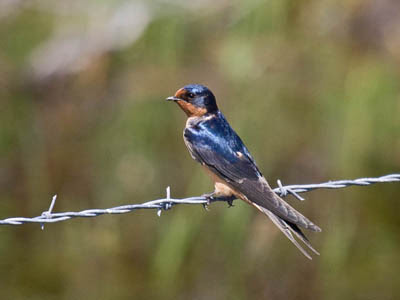 |
| Barn Swallow. Greg Gillson. |
Range in Texas: Barn Swallows are summer residents throughout Texas.
Identification:
Size: About the size of a House Finch but with a much longer tail.
Shape: Stocky, short necked but with long body and tail. Tail is forked, with very long outer tail feathers. Wings pointed.
Bill: Short, wide.
Color: Glossy dark purplish-blue above. Pinkish-orange below.
Habitat, range & behavior: Barn Swallows live in open country, frequently near humans. Farmlands. Nest in barns, under small bridges.
In North America breed from Mexico to northern Canada and Alaska, wintering from southern Mexico throughout most of South America.
Frequently seen swooping low over the ground hunting flying insects. Perch on wires, fences. Voice is twitters and chirps with grating sounds.
Food and feeder preference: Their diet is flying insects on the wing and they are not attracted to backyard feeders.
16. Ruby-crowned Kinglet (Regulus calendula)
These tiny little hyperactive balls of feathers are very similar in appearance to sluggish Hutton’s Vireos. Note the yellow feet and skinny black legs of the kinglet.
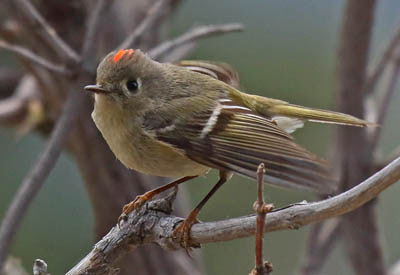 |
| Ruby-crowned Kinglet. Greg Gillson. |
Range in Texas: Ruby-crowned Kinglets are winter visitors throughout Texas.
Identification:
Size: Smaller than a chickadee or goldfinch.
Shape: Plump, almost round body with round head merging into the body almost without neck. Very short tail. Thin legs.
Bill: Very short, rather thin.
Color: Olive-green, tending toward gray, especially on the head. Paler yellow-green below. Wing gray with yellow-green edges to the wing feathers. Two white wing bars with distinctive black panel below the lower wing panel. White eye ring slightly broken on top and bottom. Red crown of male only shows when agitated. Legs very thin, black, with obvious yellow soles to the feet.
Habitat, range, and behavior: Mountain conifers in summer, brushy patches and chaparral in winter. Residential landscaping hedges and bushes.
Breeds in Alaska, across Canada, and mountains of the West. Migrates through all of US. Winters in coastal East, Southeast, West, into Mexico.
Active flitting from branch to branch, in interior of bushes and small trees, in short flap-hops. Constantly twitches wings. Hover-gleans at leaf tips.
Food and feeder preference: Ruby-crowned Kinglets feed in bushes next to house looking for spiders and insects. May eat at suet feeder.
17. Black-crested Titmouse (Baeolophus atricristatus)
You can attract these birds to nest in your backyard by putting up nest boxes.
 |
| Black-crested Titmouse. GeorgeB2 from Pixabay. |
Range in Texas: Black-crested Titmice are year-round residents from southern Texas northward in central Texas to the panhandle.
Identification:
Size: A small bird, larger than a chickadee. About the length of a House Finch.
Shape: Plump and stocky. Short neck and large head. Medium-short tail. Swept back wispy crest. Big feet.
Bill: Short, stout.
Color: Gray above, paler below. Peach color on the flanks. Black crest.
Habitat, range & behavior: Oak woods and residential trees.
Resident from northeastern Mexico through Texas.
They feed acrobatically in the twigs and small branches of trees.
Food and feeder preference: They eat insects and are especially fond of black oil sunflower seeds from hopper and tube feeders.
18. White-eyed Vireo (Vireo griseus)
Vireos are rather sluggish compared to other forest birds like warblers. They may be hard to see as they move slowly through the foliage.
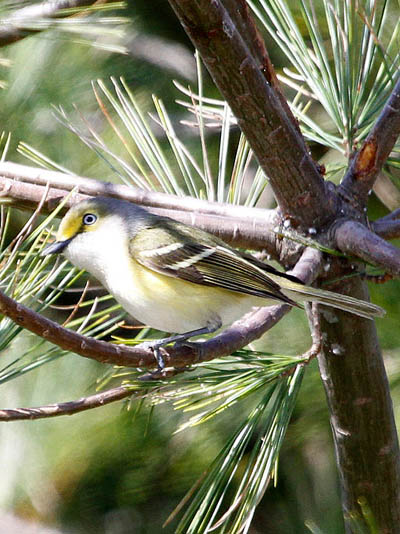 |
| White-eyed Vireo. Chuck Homler CC 3.0 |
Range in Texas: White-eyed Vireos are summer residents in the southeastern 2/3 of Texas, and year-round residents along the Gulf Coast and Lower Rio Grande Valley.
Identification:
Size: About the size of an American Goldfinch or chickadee. Smaller than a Dark-eyed Junco.
Shape: Fairly chunky. Large head. Medium tail that sticks straight out behind.
Bill: Short, but stout and hooked at the tip.
Color: Mostly gray-olive above. White below, with yellow tint on sides and flanks. Yellow spectacles. Two white wing bars.
Habitat, range & behavior: Found in scrubby habitats, forest edges, mangroves.
Year-round resident in coastal Southeast. Summer resident more extensively northward in the Eastern US.
Like other vireos, White-eyed Vireos sing throughout the heat of day in summer, when most other birds are quiet.
Food and feeder preference: They eat primarily insects, but also small fruits and berries in fall and winter. They are not attracted to bird feeders.
19. Downy Woodpecker (Dryobates pubescens)
This tiny woodpecker is found in backyards across the United States.
 |
| Downy Woodpecker. Greg Gillson |
Range in Texas: Downy Woodpeckers are year-round residents in the northeastern half of Texas.
Identification:
Size: Bigger than a junco or House Finch. Smaller than a Red-winged Blackbird. About the same size as a White-crowned Sparrow, but with a much shorter tail.
Shape: Stocky with large head and short stiff tail.
Bill: Short, chisel shaped.
Color: Black-and-white striped head. Black wings with white spots. Solid white back. White under parts. Black tail with white outer tail feathers with black bars or spots. Male with small red spot at back of head.
Habitat, range & behavior: Found in small deciduous trees, willows, and even weed stocks such as teasel, especially near water.
Ranges coast-to-coast across all but northernmost parts of Canada and Alaska south to the southern US. Absent in the desert southwest.
Interestingly, I learned today that the males may more often be found in smaller plants and twigs, while females are more likely on tree trunks.
Food and feeder preference: Diet is insects, fruits, and seeds. Gleans arthropods from the bark of trees. Attract with suet feeder. Will also eat black oil sunflower seeds.
20. Orange-crowned Warbler (Leiothlypis celata)
This common warbler migrates south to winter along the US coasts and Mexico. Thus, it is one of the first to migrate north in the spring and show up in your yard.
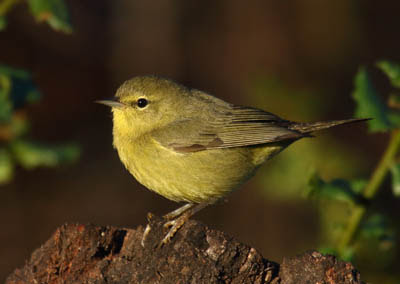 |
| Orange-crowned Warbler. Greg Gillson. |
Range in Texas: Orange-crowned Warblers are migrants in spring and fall throughout Texas. Some winter along the Gulf Coast, especially in the Lower Rio Grande Valley.
Identification:
Size: Small. About the size of American Goldfinches.
Shape: Rather round and short necked. Short tail.
Bill: Short, sharply pointed.
Color: Western birds are rather yellow-green overall with broken yellow eye ring. Eastern birds have gray heads and broken white eye ring. Green under tail coverts separates them from similar Tennessee Warbler. Males have red bases to some feathers on the head.
Habitat, range & behavior: Found in willows, deciduous woods, chaparral.
These birds breed in Alaska and across Canada, and in mountains of the West to southern California, Arizona, New Mexico. Winter along the US coasts, through Mexico. They migrate in spring and fall through the entire United States, except Maine and New Hampshire.
These birds are usually found in low shrubs, rather than treetops. The orange crown feathers may be raised in agitation when two males encounter each other during the breeding season. Otherwise, these namesake feathers are rarely seen.
Food and feeder preference: They primarily eat insects. They will eat at suet feeders in winter.
21. American Goldfinch (Spinus tristis)
A beautiful tiny backyard finch familiar to many in its bright yellow summer plumage. Colloquially called a “wild canary.”
 |
| American Goldfinch. Greg Gillson |
Range in Texas: American Goldfinches are winter visitors throughout Texas, they are year-round residents in the northeastern tip of Texas.
Identification: This is a key species for comparing with an unknown bird.
Size: Very small at about 5 inches from bill tip to tail tip. Similar in size to a chickadee. Larger than hummingbirds. Smaller than juncos and House Finches.
Shape: Tiny, somewhat plump with larger head and short tail.
Bill: Short, conical, pink.
Color: Males in summer are bright lemon yellow with black forehead and black wings and tail with white bars. White under tail coverts. Females are dull olive, wings and tail browner. Winter birds are pale grayish-yellow with tan and brown wings and tail.
Habitat, range & behavior: This species is found in weedy fields and similar clearings with thistles and similar plants.
It is found coast-to-coast throughout the year across most of the middle lower-48 states. In summer moves north to the Canada border. In the winter found south to the Mexico border.
The flight is highly undulating, rising and falling as they flap in short bursts.
Besides a long, sweet lilting song, they call in flight a lilting 4-part: “potato chip!”
Food and feeder preference: Feeds on weed seeds, thistle seed. May eat black oil sunflower seeds from tube feeder. Attract with Niger seed in a feeder called a “thistle sock.”
You may like my in-depth article on attracting American Goldfinches.
22. American Robin (Turdus migratorius)
This familiar bird is a backyard resident in the northern half of the United States and a common winter visitor in the southern half.
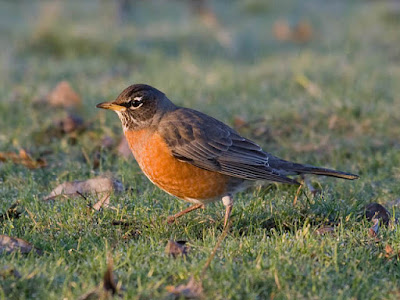 |
| American Robin. Greg Gillson. |
Range in Texas: American Robins are year-round residents throughout most of Texas, but winter visitors only along the Mexican border.
Identification: This is a key species for comparing with an unknown bird.
Size: 10 inches long from bill tip to tail tip. About the same size as a Blue Jay or one of the Scrub-Jays. Larger than Red-winged Blackbird. Smaller than a Mourning Dove.
Shape: Very plump with a fairly long tail.
Bill: Straight and fairly slender, curved at the tip.
Color: Gray-brown upperparts, rusty orange breast.
Habitat, range & behavior: Open woodlands, farmlands, urban parks and lawns.
Migratory, breeds north across Alaska and Canada. Resident in most of the United States (lower 48). Winters in the United States, Mexico, to central America.
Hops on your lawn turning head this way and that looking for food. Their caroling song is one of the early signs of spring in the north.
Food and feeder preference: American Robins eat earthworms and other invertebrates in the lawn. May eat fruit from a tray feeder or the ground. Eat small berries from trees and bushes.
23. Western Kingbird (Tyrannus verticalis)
You may note these birds aggressively and noisily chasing off other birds, such as crows and hawks, from their territories. And other interloping Western Kingbirds, of course.
 |
| Western Kingbird. Greg Gillson. |
Range in Texas: Western Kingbirds are summer residents throughout Texas.
Identification:
Size: Larger than phoebes. Smaller than American Robins. The same size as Red-winged Blackbirds.
Shape: Long body with heavy chest. Large head with raised hind crown. Large bill. Long full tail. Upright posture.
Bill: Fairly long, but shorter than head, stout and wide at the base.
Color: Gray head, back, and chest. Yellow belly. Brown wings. Black tail with contrasting white outer tail feathers.
Habitat, range & behavior: Open country.
Summers in the western half of the United States and adjacent southern Canada.
Perches on electric wires, fence lines. Chases flying insects and returns to perch.
Food and feeder preference: Feeds on flying insects. Does not come to feeders.
24. Brown-headed Cowbird (Molothrus ater)
Cowbirds are small blackbirds lay their eggs in the nests of other smaller birds, such as warblers. The adoptive parents raise their young!
 |
| Brown-headed Cowbird. Greg Gillson. |
Range in Texas: Brown-headed Cowbirds are year-round residents throughout Texas.
Identification:
Size: Larger than White-crowned Sparrows, but smaller than Rose-breasted or Black-headed Grosbeaks. Smaller than other blackbirds, starlings, and grackles.
Shape: Perhaps a little bit pot-bellied. Medium length tail. Flat forehead as typical for blackbirds.
Bill: Rather thick and stout.
Color: Males are glossy black with rich brown head. Females are dusty gray-brown throughout. Long-held juvenile plumage similar to pale female, scaly, being fed by Yellow Warbler or Song Sparrow or a hundred other host species.
Habitat, range & behavior: They are found in woodlands and farms. Also, with other blackbirds in winter at shopping center parking lots.
In summer they breed across Canada and most of the United States and Mexico. In winter they move south out of Canada and occupy both coasts and southeastern States in the US.
These small blackbirds join other flocks of blackbirds in cattle feedlots. You may see cowbirds riding on the backs of cattle, sheep, or horses. They originally rode on the backs of American bison on the Great Plains but expanded when forests were cut.
Food and feeder preference: Cowbirds eat grains, seeds, and insects. They will readily come to hopper and platform feeders. They are larger and more aggressive, so keep other birds from feeders and have a big appetite!
25. Savannah Sparrow (Passerculus sanwichensis)
These birds like large open grassy fields, but during migration they may briefly show up in your lawn or weedy garden.
 |
| Savannah Sparrow. Greg Gillson. |
Range in Texas: Savannah Sparrows are winter visitors throughout Texas.
Identification:
Size: Small sparrow. Slightly larger than American Goldfinches, much smaller than White-crowned Sparrows.
Shape: Pot belly. Round head on short neck. Short narrow notched tail.
Bill: Short conical bill. Often pink.
Color: Dusty brown above with darker brown streaks on back. Creamy or white underparts with thin dark brown streaks. Variable; some populations paler, some darker. Legs pink. Brown lateral crown stripes thin, white central crown stripe. Wide pale eyebrow. White submoustachial stripe between lateral throat stripe and thin moustachial stripe. Thin brown stripe back from the eye. Most populations have yellow supralorals–the feathers above the lores, which are the feathers between eye and bill.
Habitat, range & behavior: Grassy agricultural fields, pastures, hayfields, saltmarshes.
Summer from Alaska and across Canada to the northern half of the United States. Winter in the southern US and Mexico. Resident populations on the West Coast, Mexico.
They are usually found running on the ground, flying up to fenceposts.
Food and feeder preference: Summer food is mostly insects. Winter food is mostly small grass seeds. Do not visit feeders.
26. Cedar Waxwing (Bombycilla cedrorum)
Waxy red tips to the wing feathers give these common backyard birds their unique name. Maybe it’s the fancy crest. Maybe it’s the bandit mask. Maybe it’s the yellow band at the tip of its tail. But these are one of my favorite birds.
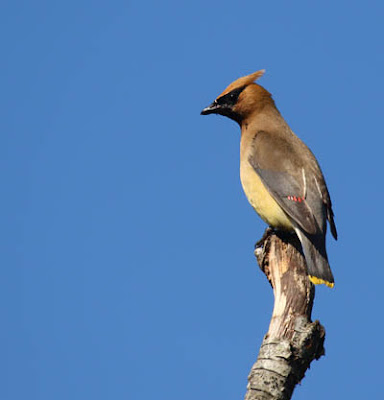 |
| Cedar Waxwing. Greg Gillson. |
Range in Texas: Cedar Waxwings are winter visitors throughout Texas.
Identification:
Size: Smaller than European Starling. Larger than House Sparrow.
Shape: Similar to European Starling. Rather stocky. Short squared tail, but long under tail coverts. Large head. Pointed wings. Wispy crest.
Bill: Rather short, small, wide.
Color: Warm brown above with wispy crest. Black mask. Yellowish belly. White under tail coverts. Gray wings. Gray tail with yellow tip.
Habitat, range, & behavior: Deciduous woods, wooded streams and lakeshores, residential shade trees, fruit orchards.
Resident across the northern US. Summer resident in Canada. Winter visitor throughout all of US and Mexico.
Keep in tight flocks. Feed in trees and large bushes for berries. Fly catch over ponds and streams.
Food and feeder preference: Diet is berries and flying insects. Usually don’t come to feeders unless fruit like cherries offered but will visit bird baths.
27. Golden-fronted Woodpecker (Melanerpes aurifrons)
These woodpeckers of the Middle Americas reach the United States only in Texas and southwest Oklahoma. They look quite similar to Red-bellied Woodpeckers.
 |
| Golden-fronted Woodpecker. GeorgeB2 from Pixabay. |
Range in Texas: Golden-fronted Woodpeckers are year-round residents in the center of Texas from north to south borders.
Identification:
Size: Larger than European Starling, about the body size of American Robin but with short tail.
Shape: Stocky body. Large head with long bill. Short stiff pointed tail. Short legs. Large feet.
Bill: Long, chisel-like.
Color: Gray body. Barred black-and-white back and wings. White wing patches at base of primaries in flight. White rump. Black tail. Yellow-orange spot on nasal tuft and hind head. Male with small red cap.
Habitat, range & behavior: Dry woodlands, mesquite, pecan groves.
Found in eastern Mexico and up through central Texas to the panhandle.
May nest in gnarled old trees in backyards.
Food and feeder preference: Eat wood boring insects, fruit, seeds. Will eat black oil sunflower seeds, peanuts, and suet.
28. Loggerhead Shrike (Lanius ludovicianus)
Shrikes are songbirds that hunt like birds of prey. They sing a mixture of warbles and harsh notes.
 |
| Loggerhead Shrike. Greg Gillson. |
Range in Texas: Loggerhead Shrikes are year-round residents throughout Texas.
Identification:
Size: They are about the same size as Northern Mockingbirds, which they resemble in gray-and-black patterning. Smaller than American Robins. About the size of a Red-winged Blackbird.
Shape: Chunky birds with big rounded heads. Tail medium length, somewhat fanned and rounded towards the end.
Bill: Stout and hooked.
Color: Top of head and back medium dark gray. White throat and under parts. Black mask. Black wings and tail with white patches and edges. Small white wing patches (compare with large wing patches of mockingbird).
Habitat, range & behavior: Open areas with brush, desert thorn scrub.
They are year-round residents across the southern United States, migrate north in the Great Plains and are summer residents there and into central Canada.
Unlike hawks and other raptors, these songbirds have weak feet. So they impale prey on thorns or barbed wire to hold them.
Food and feeder preference: They eat grasshoppers, mice, lizards, small birds. They do not come to feeders.
29. Bewick’s Wren (Thryomanes bewickii)
This is a brush-loving bird that may hide in your backyard hedges.
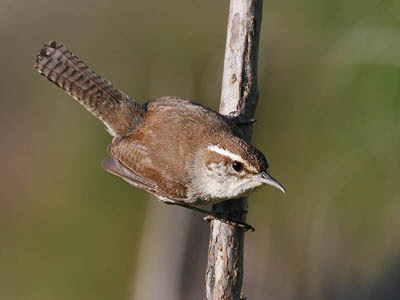 |
| Bewick’s Wren. Greg Gillson. |
Range in Texas: Bewick’s Wrens are year-round residents throughout most of Texas, winter visitors only in far eastern Texas.
Identification:
Size: These are fairly small birds, about the size of House Finches.
Shape: They are rather stocky, with short neck, long floppy tail, fairly long legs.
Bill: Long, thin, slightly curved.
Color: Different populations can be more gray or more brown. Barred brown and black tail. Pale gray under parts. The white eyebrow is diagnostic.
Habitat, range, and behavior: These birds are found in brushy tangles, chaparral, backyard bushes.
These birds live along the West Coast from southern British Columba southward into Mexico, the Southwest, east to Missouri.
They stay hidden in dense brush except in spring when they sing loudly from exposed perches.
Food and feeder preference: Bewick’s Wrens eat primarily insects and invertebrates. They will come to feeders in winter for suet.
30. Eastern Bluebird (Sialia sialis)
A beloved bird of open fields with trees and fence lines for perching.
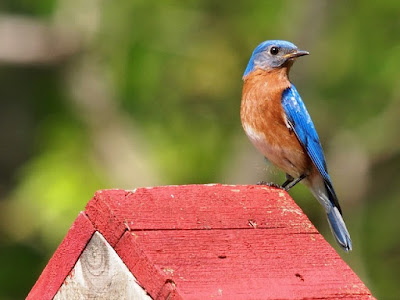 |
| Eastern Bluebird. skeeze from Pixabay |
Range in Texas: Eastern Bluebirds are year-round residents in the eastern half of Texas and winter visitors only in the western half of Texas.
Identification:
Size: Larger than House Finches. Much smaller than starlings. About length of White-crowned Sparrow but differently proportioned–bigger body, shorter tail.
Shape: Chunky, large head, short tail. Bill: Straight, fairly slender, curved at tip.
Color: Males are brilliant blue above (including wings and tail), rusty orange below with white belly and under tail. Females are often much paler, almost grayish.
Habitat, range & behavior: Found in pasture, fields, golf courses, open woodland edges.
They are resident in most of eastern US, highlands of Middle America. In summer reach northernmost eastern US and southernmost eastern Canada, withdrawing somewhat in winter.
They readily use nest boxes, but the entrance hole must be smaller than the head of a starling, and without a perch.
Food and feeder preference: They eat flying insects primarily, but also other invertebrates and berries. They will eat mealworms at your feeder and frequent birdbaths.
31. Chipping Sparrow (Spizella passerina)
Chipping Sparrows are a widespread species adapted to human disturbance. They are rather tame. They are frequently found in cemeteries with large trees.
 |
| Chipping Sparrow. Greg Gillson. |
Range in Texas: Chipping Sparrows are year-round residents in central and east-central Texas, winter visitors throughout the rest of Texas, but migrants only in the panhandle.
Identification:
Size: These are small sparrows, bigger than goldfinches or chickadees, but smaller than House Finches or Song Sparrows.
Shape: Plump and fairly long tailed.
Bill: Short and conical.
Color: Striped brown and dark brown above. Grayish under parts. Black line through eye. Crown streaked in winter but in summer becomes solid chestnut. Two white wing bars.
Habitat, range & behavior: Grassy open conifer woodlands with some shrubs, parks, orchards.
Breeds from Alaska, across Canada and south into highlands of Middle America. In winter retreats from northern areas to southern United States and northern Mexico.
In summer solitary or in pairs. In winter they forage in flocks of up to 50 birds.
Food and feeder preference: Diet is weed seeds, supplemented with insects in summer. They may eat black oil sunflower seeds in your feeder, but more likely will feed on mixed seeds on the ground under the feeder.
32. Scissor-tailed Flycatcher (Tyrannus forficatus)
This is a common open country bird in the southern Great Plains.

Range in Texas: Scissor-tailed Flycatchers are summer residents throughout Texas.
Identification:
Size: These birds are about the size of Western Kingbirds, but the outer tail feathers are extremely long. The body is smaller than an American Robin. The body is larger than Eastern Phoebe.
Shape: Typical flycatcher shape with large head full belly. Long tail with extremely long outer tail feathers as long as the rest of the bird.
Bill: Stout. Flat. Wide.
Color: Pale gray on head, back, breast. Peach-colored flanks. Blackish wings and tail with broad pale edges.
Habitat, range & behavior: Open land, pastures, scrubby fields with small trees.
Breeds on southern Plains States. Winters in Middle America.
Pairs defend their breeding territory by chasing others of their kinds, but also hawks, grackles, shrikes, crows, and other birds.
Food and feeder preference: They eat insects they catch on the wing. They do not come to feeders.
33. Painted Bunting (Passerina ciris)
Who spilled the paint-by-number set on this bird? Wow! An amazing variety of colors all on one bird.
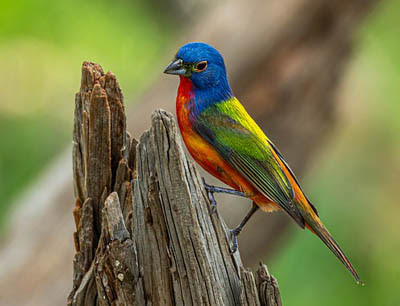 |
| Painted Bunting. Israel Alapag from Pixabay. |
Range in Texas: Painted Buntings are summer residents throughout Texas, rarer along the New Mexico border.
Identification:
Size: Small. Larger than American Goldfinch. Smaller than House Sparrow.
Shape: Chunky with large round head. Shorter tail with notched end. Heavy bill.
Bill: Short and triangular with heavy base.
Color: Females are yellow-green throughout, slightly darker above. Males have a blue hooded head with red eye ring and red belly and throat. They have a bright yellow-green back. The lower back and rump is red. The wings and tail are variable with blues and greens.
Habitat, range & behavior: Overgrown grassy fields and brushy road edges. Old farms.
Two separate populations. Found in southern Plains States and Atlantic coastal Southeast.
They tend to hide in dense thickets.
Food and feeder preference: Most of the year they eat seeds from grasses and low ground plants, but feed insects to their young and switch to mostly insects during the breeding season. They visit backyard hopper feeders for seeds in later summer.
34. Black-chinned Hummingbird (Archilochus alexandri)
The throat feathers of all male hummingbirds are black. Only when light is refracted at just the right angle do those brilliant gemstone colors appear. For this species, however, the throat appears black all the time, except for some deep purple feathers at the bottom of the gorget.
Range in Texas: Black-chinned Hummingbirds are year-round residents in the Lower Rio Grande Valley. Elsewhere, these birds are summer residents in the western half of Texas.
Identification:
Size: Tiny.
Shape: Round body with large head and not much neck. Tail fairly long for a hummingbird. Long wings don’t quite extend to tail tip when perched. Long needle-like bill.
Bill: Long tubular, slightly downcurved.
Color: Green above and crown. White below with dusky green sides. White wraps up part way around neck like a collar, strongly contrasts with dark throat of male. Female has white throat, gray crown.
Habitat, range & behavior: River canyons, arid areas. Sycamores, oaks.
Summer residents in deserts of the West and Southwest from interior British Columbia south through California and Texas.
Food and feeder preference: Diet is insects and spiders, flower nectar. Readily attracted to hummingbird feeders.
35. Chimney Swift (Chaetura pelagica)
Swifts have such small weak feet that they cannot perch on wires or trees like swallows. Look for them high in the air chasing bugs with rapid wingbeats.
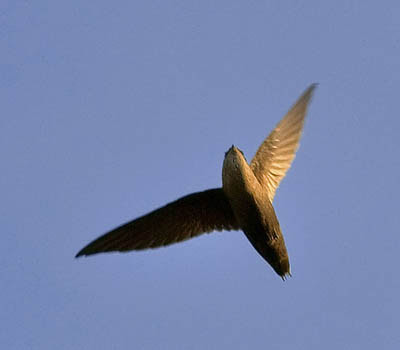 |
| Chimney Swift. Jim McCulloch CC 2.0 |
Range in Texas: Chimney Swifts are summer residents in eastern Texas and the panhandle area.
Identification:
Size: Small bird. Smaller than House Finches or Cliff Swallows.
Shape: Small head on short neck, very short tail. Thin pointed wings with no apparent bend at the wrist as most other birds.
Bill: Very short, wide.
Color: Gray-brown throughout.
Habitat, range & behavior: Open sky, above forests or residential areas.
They are summer residents east of the Rockies from southern Canada southward. They do not winter in the United States.
In fall migration they form large flocks of hundreds or thousands and swirl into large chimneys at dusk. Because the upper arm is so short as to barely exist, the flight of swifts is described as rapid and twinkly, not smooth and graceful as swallows.
Food and feeder preference: Insects caught on the wing. Will not visit feeders.
36. Red-winged Blackbird (Agelaius phoeniceus)
These noisy flocking birds are most often found in marshes. But in winter they are found in backyards.
 |
| Male Red-winged Blackbird. Greg Gillson. |
 |
| Female Red-winged Blackbird. Greg Gillson. |
Range in Texas: Red-winged Blackbirds are year-round residents throughout Texas.
Identification: This is a key species for comparing with an unknown bird.
Size: About 8-3/4 inches long from bill tip to tail tip. About the size of a Northern Cardinal. Smaller than an American Robin.
Shape: Pot-bellied with a longer bill and flat forehead. Tail average.
Bill: Long and sharp pointed.
Color: Males are black with red and yellow shoulder patch. Females are streaked brown and rusty (sparrow-like but pointed bill and flat forehead).
Habitat, range, and behavior: Cattail marshes and wetlands are their summer habitat. In winter they feed in grain fields.
They breed across most of the North American continent. In winter they withdraw from most of Alaska and Canada.
They are found in colonies in summer and large flocks in winter.
Food and feeder preference: They eat insects in summer. In winter they eat grain and seeds. They visit feeders, more often in large winter flocks, and eat most seeds and suet.
Common Birds in Texas
To determine how common each species is I used the data from actual bird sightings from the citizen science program eBird. Birds are listed by frequency. That is, how often the species is recorded on checklists submitted to eBird (a percentage).
When choosing the birds to include in this article I leaned strongly to birds that are present throughout the year in good numbers. Thus, many of the common birds are year-round residents. This means that they live in the same location all year. They raise their young in your neighborhood. They don’t migrate. Or if the species does migrate, the ones living in your area don’t. If this is the case, some migrants may move into your area during certain times of year, adding to the same species that are in your yard full time.
Some migrant birds visit your yard during the “summer.” Often, they arrive in spring and remain until late fall. They nest and raise their young in your neighborhood. These are the summer residents.
Other migrant birds visit your backyard during the “winter.” Some of these winter visitors may arrive in July and remain into April. Others may only be found in the cold of December or January. They key here is that they nest and raise their young somewhere else. They only visit your yard in the non-breeding season.
Migration is an amazing spectacle.
There will be birds that fly through your region in spring or fall (or both). They may visit your backyard only a few days or weeks a year. They aren’t regular enough, or stay long enough, to be included in this article. But the number of briefly visiting migrant birds could double the number of species presented here. You may see them over time. Consult checklists in eBird for your county to see what is possible.
I have generally excluded common waterfowl, birds of prey, shorebirds, seabirds, and others that aren’t usually found in residential areas. But they may certainly fly over or be seen regularly if your home is on a shoreline, for instance.
Most common backyard birds in Texas throughout the year
The following list is the backyard birds that are, on average, most common throughout the entire year. The list is ordered by most common based on the frequency of how often each species is recorded on checklists submitted to eBird.
- Northern Cardinal (49% frequency)
- Northern Mockingbird (45%)
- Mourning Dove 36%
- White-winged Dove (30%)
- Blue Jay (25%)
- Carolina Chickadee (25%)
- Carolina Wren (25%)
- House Sparrow (23%)
- European Starling (21%)
- Red-winged Blackbird (21%)
- Eastern Phoebe (19%)
- Yellow-rumped Warbler (18%)
- American Crow (17%)
- House Finch (17%)
- Red-bellied Woodpecker (16%)
- Barn Swallow (16%)
- Ruby-crowned Kinglet (15%)
- Black-crested Titmouse (13%)
- White-eyed Vireo (13%)
- Downy Woodpecker (12%)
Most common backyard birds in Texas in winter
- Northern Cardinal (48% frequency)
- Northern Mockingbird (42%)
- Yellow-rumped Warbler (36%)
- Mourning Dove (29%)
- Ruby-crowned Kinglet (28%)
- Eastern Phoebe (27%)
- Carolina Chickadee (26%)
- Blue Jay (24%)
- Carolina Wren (23%)
- White-winged Dove (23%)
- Red-winged Blackbird (22%)
- Orange-crowned Warbler (22%)
- House Sparrow (21%)
- American Goldfinch (20%)
- European Starling (19%)
- American Crow (19%)
- American Robin (18%)
- Red-bellied Woodpecker (17%)
- House Finch (16%)
- Black-crested Titmouse (14%)
- Savannah Sparrow (14%)
- Cedar Waxwing (13%)
- Golden-fronted Woodpecker (13%)
- Loggerhead Shrike (13%)
- Downy Woodpecker (13%)
- Eastern Bluebird (12%)
- Chipping Sparrow (12%)
Most common backyard birds in Texas in summer
- Northern Mockingbird (52% frequency)
- Northern Cardinal (52%)
- Mourning Dove (46%)
- White-winged Dove (38%)
- House Sparrow (30%)
- Barn Swallow (28%)
- Carolina Wren (26%)
- Blue Jay (26%)
- Carolina Chickadee (25%)
- Scissor-tailed Flycatcher (22%)
- House Finch (21%)
- Painted Bunting (20%)
- European Starling (20%)
- Red-winged Blackbird (17%)
- White-eyed Vireo (16%)
- Red-bellied Woodpecker (15%)
- Western Kingbird (15%)
- American Crow (15%)
- Brown-headed Cowbird (15%)
- Black-chinned Hummingbird (14%)
- Chimney Swift (13%)
- Black-crested Titmouse (14%)
- Bewick’s Wren (12%)
Winter brings some northern species out of the cold to winter in Texas: Yellow-rumped Warblers, Ruby-crowned Kinglets, Eastern Phoebes, Orange-crowned Warblers.
Barn Swallows are common Texas birds in backyards and neighborhoods that are more common in summer than year-round.
Common Backyard Birds of Dallas and Fort Worth, Texas
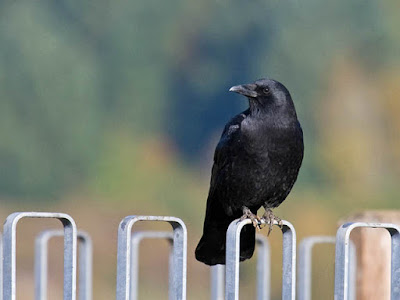 |
| American Crow. Greg Gillson |
- Northern Cardinal (51% frequency)
- Blue Jay (46%)
- Northern Mockingbird (42%)
- American Crow (42%)
- Mourning Dove (39%)
- Carolina Chickadee (38%)
- European Starling (32%)
- Carolina Wren (28%)
- Red-bellied Woodpecker (28%)
- White-winged Dove (25%)
- Rock Pigeon (24%) Learn about this species on eBird
- Downy Woodpecker (24%)
- House Sparrow (23%)
- Tufted Titmouse (22%) Learn about this species on eBird
- Eastern Phoebe (20%)
A city bird, Rock Pigeon, is more common in the Dallas, Texas area than the state as a whole.
Red-bellied Woodpecker, Tufted Titmouse, and American Crow reach eastern Texas and the Dallas area, but not the western portion of the state.
Eastern Phoebe is a resident in northeastern Texas, a summer visitor in the northern parts, but only a winter visitor in the southern parts.
Common Backyard Birds of Houston, Texas
 |
| Red-bellied Woodpecker. skeeze from Pixabay |
- Blue Jay (57% frequency)
- Northern Cardinal (56%)
- Northern Mockingbird (55%)
- Mourning Dove (43%)
- White-winged Dove (38%)
- Red-bellied Woodpecker (36%)
- Carolina Chickadee (33%)
- Carolina Wren (30%)
- Downy Woodpecker (30%)
- European Starling (29%)
- House Sparrow (28%)
- American Crow (23%)
- Yellow-rumped Warbler (23%)
- American Robin (20%)
Red-bellied Woodpecker and American Crow only reach the eastern half of Texas. That’s why they’re on this list.
Migrant and winter Yellow-rumped Warblers and American Robins are a bit more regular in the Houston area than the state as a whole.
Common Backyard Birds of Austin and San Antonio, Texas
- Northern Cardinal (60% frequency)
- White-winged Dove (52%)
- Northern Mockingbird (47%)
- Carolina Wren (44%)
- Carolina Chickadee (40%)
- Great-tailed Grackle (39%) Learn about this species on eBird
- Blue Jay (37%)
- Mourning Dove (31%)
- House Finch (28%)
- Eastern Phoebe (27%)
- European Starling (27%)
- House Sparrow (26%)
- Lesser Goldfinch (24%) Learn about this species on eBird
- Black-crested Titmouse (22%)
- Yellow-rumped Warbler (22%)
- Red-bellied Woodpecker (20%)
- American Crow (20%)
- Ruby-crowned Kinglet (20%)
Common Backyard Birds of Amarillo, Texas
- Great-tailed Grackle (40% frequency) Learn about this species on eBird
- European Starling (30%)
- Eurasian Collared-Dove (37%) Learn about this species on eBird
- House Sparrow (33%)
- House Finch (32%)
- Mourning Dove (32%)
- White-winged Dove (26%)
- American Robin (25%)
- Red-winged Blackbird (21%)
- Barn Swallow (21%)
- Northern Mockingbird (20%)
The common birds in Amarillo are a bit different than in the rest of Texas.
Great-tailed Grackles and Eurasian Collared-Doves are more common than the state average.
Northern Cardinals, Blue Jays, Carolina Wrens, Carolina Chickadees, and Eastern Phoebes are much less common.
Common Backyard Birds of Galveston, Texas
- Great-tailed Grackle (41% frequency) Learn about this species on eBird
- Northern Mockingbird (39%)
- Northern Cardinal (31%)
- European Starling (26%)
- Mourning Dove (23%)
- Barn Swallow (22%)
- Red-winged Blackbird (22%)
- Blue Jay (20%)
- Gray Catbird (19%) Learn about this species on eBird
- Loggerhead Shrike (18%)
On the coast, Galveston has lots of gulls and waders. You may see these flying over your backyard.
Great-tailed Grackles are more common here than in the state as a whole. Gray Catbird is another bird that shows up as common here that is less so than the state average.
On the other hand, several backyard birds are missing or much less common in Galveston than elsewhere in the state. White-winged Dove, House Sparrow, Carolina Wren, Carolina Chickadee, and Eastern Phoebe are less common here.
Wrapping Up
Texas, with its diverse habitats from arid deserts to lush forests, is home to an incredible variety of birds. Over 500 species have been recorded in the state, making it a birdwatcher’s paradise. Here are some of the most common birds you’re likely to encounter in the sider areas of Texas:
Water Birds:
- Brown Pelican: The state bird of Texas, the brown pelican with its huge beak is a graceful sight soaring over coastal waters and diving for fish. They are common along the Gulf Coast and can also be seen inland near lakes and rivers.
- White Ibis: These tall, white wading birds with curved beaks are found in marshes and shallow water, often seen in large flocks. They are common along the coast and can also be found inland near lakes and rivers.
- Mallard Duck: This familiar duck with its green head and brown body is common in lakes, ponds, and rivers across Texas. They are readily seen in both urban and rural areas.
- Great Egret: These elegant white birds with long legs and beaks are seen stalking prey in wetlands and along shorelines. They are common throughout the state, from marshes to rice fields.
Open Country Birds:
- American Kestrel: This small falcon with a rusty back and pointed wings hovers over fields and meadows, hunting for insects and small rodents. They are common in open country across Texas, including farms, grasslands, and prairies.
- Mourning Dove: These slender, grayish-brown birds with a mournful cooing call are often seen around barns and fields. They are common in open country throughout Texas, readily nesting in trees and shrubs.
- Blue Jay: These noisy and colorful birds with bright blue plumage and a crest are common in both woodlands and open areas. They readily visit feeders and nest in trees.
- Common Grackle: These large, blackbirds with iridescent purple-green feathers are abundant in fields and marshes, often forming large flocks. They are common in both urban and rural areas across Texas.
Frequently Asked Questions
What is the state bird of Texas?
The state bird of Texas is the Northern Mockingbird. This talented mimic with its impressive repertoire of songs is a familiar sight and beloved symbol of the Lone Star State.
They thrive in diverse habitats across Texas, from backyards and parks to open fields and woodlands. Their bold personalities, adaptability, and beautiful songs have captured the hearts of Texans, making them a fitting representation of the state’s spirit and resilience.
What is the aggressive Texas bird?
Yes, grackles can be aggressive birds, particularly during specific contexts like breeding season, defending territory, and competing for food sources. Here’s a breakdown of their aggressive tendencies:
Types of aggressive behavior:
- Diving and swooping: They may dive-bomb and swoop at humans or other animals perceived as threats, particularly near their nests or during breeding season.
- Vocal aggression: They use loud calls and chirps to intimidate rivals or warn intruders away from food sources.
- Physical attacks: In extreme cases, grackles can physically attack other birds, including smaller species, by pecking and chasing them.
Contributing factors:
- Flock behavior: Their tendency to gather in large flocks can amplify their competitiveness and aggression, especially over food.
- Habitat loss: Urbanization and habitat loss can lead to increased competition for resources, pushing grackles to exhibit more aggression.
- Opportunistic feeding: Their scavenging nature can lead them to compete with other birds for food sources, triggering aggressive behavior.
However, it’s important to note that:
- Not all grackles are aggressive all the time. Their behavior can vary depending on individual temperament, the situation, and the perceived threat.
- Many grackles peacefully coexist with humans and other birds. Proper management of food sources and avoiding interference with nesting sites can help minimize conflicts.
- Aggression is a natural behavior in many animal species, including birds. It serves vital roles in survival, territory defense, and reproduction.
The White-winged Dove is a really attractive bird and can be found across Texas. Finding the White-winged Dove in Texas depends on factors like the time of year and your desired location. Here’s a breakdown of their whereabouts:
Habitat:
- South Texas: Their primary breeding grounds are in the mesquite-acacia-prickly pear scrublands of South Texas, particularly near the Rio Grande River and extending north to Laredo and Del Rio.
- Central Texas: Smaller breeding populations can be found in the Edwards Plateau region, including areas around Uvalde, Kinney, and Medina counties.
- Urban areas: White-winged Doves readily adapt to urban environments and can be found in cities and towns throughout Texas, thriving in parks, gardens, and even rooftops.
Seasonality:
- Breeding season: This occurs from March to October, when they are most likely found near their preferred breeding grounds in South and Central Texas.
- Wintering: During the colder months (November to February), their range expands, and they can be seen throughout Texas, including coastal areas and even farther north in the Dallas-Fort Worth metroplex.
Specific Locations:
- Wildlife refuges: Refuges like the Welder Wildlife Foundation and Santa Ana National Wildlife Refuge offer excellent opportunities to spot White-winged Doves in their natural habitats.
- State parks: State parks like Bentsen-Rio Grande Valley State Park and Palmetto State Park provide good viewing opportunities, especially during breeding season.
- Urban parks and gardens: Look for them in parks and gardens with mature trees and open spaces, particularly in cities like San Antonio, Austin, and Del Rio.
Tips for finding them:
- Listen for their distinctive cooing call: It’s a soft, musical “coo-coo-coo” that they use to communicate.
- Look for them in flocks: They often forage and fly in small groups, particularly around feeding areas.
- Pay attention to their favorite foods: They feed on seeds, fruits, and insects, so look for them near trees, shrubs, and flowerbeds.
- Use birding resources: Websites like eBird and the Cornell Lab of Ornithology’s Merlin Bird ID app can help you find recent sightings and predicted locations.
________________________________________________________________________________________________
Related Articles: 34 of the most common birds in the United States (with photos)











Loved the information on backyard birds! That’s been our respite from the world since Covid. The birds keep us busy with their not so bird-like appetites. Love nature in our own backyard!
Msbperry 47,
Yes, there's always something to see with the birds, no matter where we are.
This was good and informative. Can’t think of any changes that the website needs though.
This was good and informative. Can’t think of any changes that the website needs though.
Thanks David!
I saw a very small Green colored bird with yellowish breast. Pointed beak. Amongst the foliage catching small insects. Cannot seem to find anything like it wherever I Google. Help! Now I’m a hooked bird watcher and will research until I’m satisfied in my ability to identify this creature and others with gossamer wings.
Yep. That's how it happens. You're a birder now!
There are so many small green birds with yellow breasts–it's a common color combination. Probably a warbler–Wilson's or Common Yellowthroat, but vireo, oriole, and flycatchers might not be ruled out.